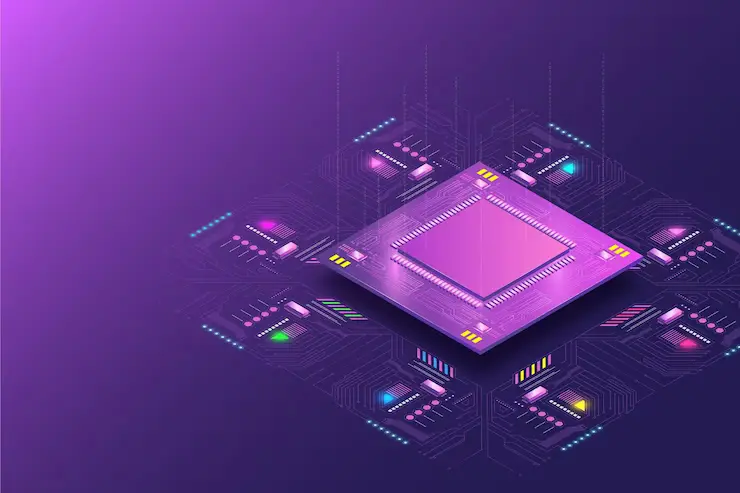
Inside the Integrated Chip: Understanding the Building Blocks of Modern Devices
- May 09, 2023
- | 310
What is an Integrated Chip?
Integrated chips, also known as microchips or integrated circuits (ICs), are electronic circuits made up of numerous microscopic components Such as transistors, diodes, and capacitors. Which are all incorporated into a single piece of semiconductor material. These chips, which are use in several electrical equipment, are design to perform specific functions. Electrical engineering, computer science, and semiconductor physics require a high level of skill to create and manufacture integrated chips. Several chip design companies have specialized in designing and producing integrated chips for a range of applications, including consumer electronics, aircraft, and defense.?Different types of ICs
Different IC configurations are available, each with a specific purpose- Microprocessors: Also known as integrated circuits (ICs), these are the "brains" of a computer or other electronic device, doing all computations and processing necessary to run the latter.
- Memory chips: By storing data and program code, these ICs help devices quickly access and use data.
- Power management ICs: These chips control the quantity of electricity that is send to each section of a device, ensuring that each part is receiving the proper amount of power.
- Radiofrequency (RF) ICs: Radiofrequency (RF) ICs enable Bluetooth, Wi-Fi, and cellular connectivity by allowing devices to communicate wirelessly via radio waves.
Building Blocks of ICs
Integrate circuits (ICs), despite being small, are immensely sophisticate components consisting of several fundamental building pieces. These foundational elements include:- Transistors: Transistors are the essential building blocks of integrated chips. They switch or amplify electronic impulses and are compose of three layers of semiconductor material.
- Diodes: Electrical diodes control the current flow in a circuit. These devices, which are make of two layers of semiconductor material, can be use as both rectifiers and voltage regulators.
- Capacitors: Used to store electrical charge, capacitors are components that use two conducting plates separated by an insulating substance.
- Resistors: To manufacture resistors, which are use to limit the flow of electricity in a circuit, a length of resistive material is use.
- Inductors: These are electronic components with a wire coil that are use to store energy in magnetic fields.
- Memory: Memory, which can be volatile or non-volatile, serves as a storage medium for both data and programming instructions.
- Microprocessors: The microprocessor, which serves as the integrate chip's brain, is in charge of executing the instructions from the programs that are keep on the chip.
- Logic Gates: Logic gates are electronic components that perform basic logical operations like AND, OR, and NOT.
- Multiplexers and Demultiplexers: By switching between multiple inputs and outputs, these components, also known as multiplexers and demultiplexers, allow the chip to do complex tasks.
Process for Designing VLSI Chips
Designing integrated chips is a labor-intensive, multi-stage process that takes a lot of time. The essential phases of creating an integrated chip are as follows:- Specification: Understanding the specifications of the VLSI chip, such as the tasks it must carry out, the amount of power it must consume, and the size of the chip, is required at this stage. Working closely with the client to comprehend their wants and requirements is part of this stage.
- Design: The design phase entails producing a thorough schematic of the chip that shows where each component is located and how they are connected. High levels of knowledge in electronics and computer-aid design (CAD) software are need for this step.
- Verification: To make sure the semiconductor design complies with the requirements, the verification stage comprises testing the design using simulation tools. At this stage, the embedded electronic system design is reviewed for faults and adjusted as necessary.
- Masking: Making a physical mask for the chip is the next step after the design has been validated. During the manufacturing process, this mask is use to create the various layers of the chip.
- Fabrication: During the fabrication phase, a technique called photolithography is used to create the actual chip. The multiple chip layers are etch onto a piece of semiconductor material, typically silicon, using the mask in this process.
- Packaging: The last step is to package the chip, which entails adding power and data connectors and encasing it in a protective covering.
The Prospects of ICs
The need for electronic gadgets that are more effective and powerful will only increase as technology develops. As a result, IC design firms will need to innovate and create new technologies to meet demand. In the upcoming years, a few of the areas that are project to experience considerable growth are as follows:- Internet of Things (IoT): An interconnected network of devices that can exchange data and communicate with one another is referred to as the IoT. The development of IoT devices will be greatly facilitate by ICs.
- Artificial intelligence (AI): Artificial intelligence (AI) is playing a bigger role in a variety of fields, including self-driving automobiles and healthcare. The complex algorithms and processing need for AI will be power by ICs.
- Edge Computing: Edge computing is the processing of data away from the cloud, at the device or network edge. To make this kind of processing possible, which can result in quicker and more effective data processing, ICs will be require.





